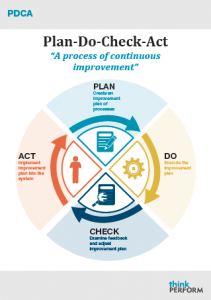How to properly define Continuous Improvement and its application in the workplace
How to properly define Continuous Improvement and its application in the workplace

Consider a production process where every week there was a small but helpful change implemented to the procedure. For example, a new and improved tool might be introduced one week, a new part which replaces two parts the next week, a new layout with easier to reach tools the next – and so on. Each of these changes are small, but these small incremental changes over time would greatly enhance the production process.
What is a Continuous Improvement Cycle?
A continuous improvement cycle provides a foundation for the implementation of a number of Lean tools which aim to improve organisational processes, services and products. Put simply, a continuous improvement cycle is one of the most successful means by which an organisation can achieve its long-term goals through design, strategy and application.
What is a Continuous Improvement Plan?
Generally, a Continuous Improvement plan it follows the PDCA cycle. The cycle begins with a strategy or plan, which is then implemented. When a predetermined amount of time has passed, the process is reviewed and evaluated. Depending upon the outcome, the plan is tweaked and the PDCA cycle begins again.
For example, imagine a car parts company that is frequently ending up with a lot of waste. During the plan phase, the employees could use lean tools like the 5 Whys or a Fishbone diagram to determine why this is happening. From here, they can develop a plan to reduce waste.
In the do stage, the employees implement the plan, which may involve a 5S blitz [link to 5s infographic] on their work area to improve efficiency and reduce waste. After a pre-defined period of time they would review and evaluate the effectiveness of their actions.
During the check phase they can measure whether their changes are reducing waste across the pre-defined areas marked for improvement e.g. reduction of defects, excessive production or waiting.
The act phase encourages employees to take action and implement any learnings in other areas of the workplace and continue to identify areas for improvement.
How does the PDCA cycle influence long term results?
Using the PDCA cycle is like a type of perpetual loop. It moves from planning, to implementation, to evaluation, to revision, and then back to planning and on again. It is precise and methodical. One of its key benefits is that it does not allow for organisational stagnation. Factors such as perceived vulnerabilities, areas for improvement, employee participation, and client satisfaction are monitored, measured, and manipulated to facilitate improvement. Many organisations have noted greater levels of improvement when employees who will be impacted by the changes under consideration are included in the planning and evaluation stages of the process.
How is a Successful Continuous Improvement Implementation Assessed?
The success of many business initiatives are frequently determined by profits. They can also be measured by factors such as increased competitiveness, sustainability, quality, safety, production and retention. Factors like loss reduction, client satisfaction and identification of waste are analysed when determining goals for organisational change. By comparing these statistics to baseline measurements, an organisation’s improvements are able to be statistically measured.
It is clear from looking at the history of successful companies that long term approaches, such as continuous improvement, cannot be abandoned if future growth is the objective. Click here to download a handy Plan, Do, Check, Act printable poster. Print it out and place it where your employees can read, review and memorise the cycle.
If your organisation is looking to improve profitability, competitiveness and sustainability, spend 3-5 minutes taking the Workplace Waste Analysis and you will be provided with a customised report to help identify and reduce waste in your workplace. Click here to take the analysis.


